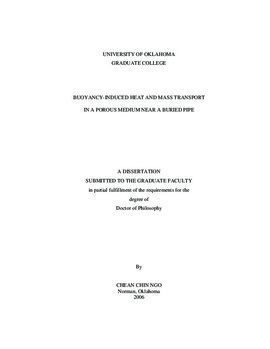| dc.contributor.advisor | Lai, Feng Chyuan, | en_US |
| dc.contributor.author | Ngo, Chean Chin. | en_US |
| dc.date.accessioned | 2013-08-16T12:20:26Z | |
| dc.date.available | 2013-08-16T12:20:26Z | |
| dc.date.issued | 2006 | en_US |
| dc.identifier.uri | https://hdl.handle.net/11244/1114 | |
| dc.description.abstract | The heat and mass transport in a porous medium induced by buoyancy from a buried heated pipe has been examined in this study. Due to the complexity and irregularity of geometry involved, body-fitted coordinate systems along with finite difference scheme were employed. First, the solutions for conduction and natural convection in a homogeneous porous medium were obtained and compared with the results available in the literature. | en_US |
| dc.description.abstract | Another area of interest is to predict how heat and mass transport when there is a breakage in the pipe. Numerical solutions are thus obtained for combined heat and mass transfer by mixed convection induced from a buried pipe with leakage. Two locations of leakage are considered in this study: one is on top of the pipe and the other is at the bottom of the pipe. The effects of Rayleigh number, Peclet number, Lewis number, and buoyancy ratio on the heat and mass transfer results have been examined. The results suggest that both the Nusselt number and Sherwood number increase for the aiding flows and decrease for the opposing flows. For aiding flows, Sherwood number increases with an increase in the Lewis number but Nusselt number behaves otherwise. | en_US |
| dc.description.abstract | Realizing that the properties of porous medium immediate around the pipe are usually different from those of the surrounding medium, the objective of this particular study is to investigate how a step change in the permeability of the backfill would affect the flow patterns and heat transfer results. Numerical solutions have been obtained for natural convection in a heterogeneous porous medium induced by a buried heated pipe. The concept of imaginary nodal points has been used to derive the interface conditions. A wide range of governing parameters (e.g., base Rayleigh number and permeability ratio) for various backfill thicknesses have been covered in the computations. It is found that a more permeable backfill can minimize the heat loss and confine the flow to a region near the pipe. | en_US |
| dc.description.abstract | Flow visualization experiments were conducted using two Hele-Shaw cells, which simulated a porous medium with distinct permeabilities, subjected to different pipe temperature for both permeable and impermeable top boundaries. Using time-elapsed photographs, it revealed that the flow fields for permeable and impermeable top boundaries displayed distinct characteristics. The flow fields predicted by numerical work for the impermeable top boundary were in good agreement with those observed in experiment. | en_US |
| dc.format.extent | xviii, 219 leaves : | en_US |
| dc.subject | Transport theory. | en_US |
| dc.subject | Heat Transmission. | en_US |
| dc.subject | Soil physics. | en_US |
| dc.subject | Porous materials. | en_US |
| dc.subject | Engineering, Mechanical. | en_US |
| dc.title | Buoyancy-induced heat and mass transport in a porous medium near a buried pipe. | en_US |
| dc.type | Thesis | en_US |
| dc.thesis.degree | Ph.D. | en_US |
| dc.thesis.degreeDiscipline | School of Aerospace and Mechanical Engineering | en_US |
| dc.note | Source: Dissertation Abstracts International, Volume: 67-10, Section: B, page: 6018. | en_US |
| dc.note | Adviser: Feng Chyuan Lai. | en_US |
| ou.identifier | (UMI)AAI3238557 | en_US |
| ou.group | College of Engineering::School of Aerospace and Mechanical Engineering | |
